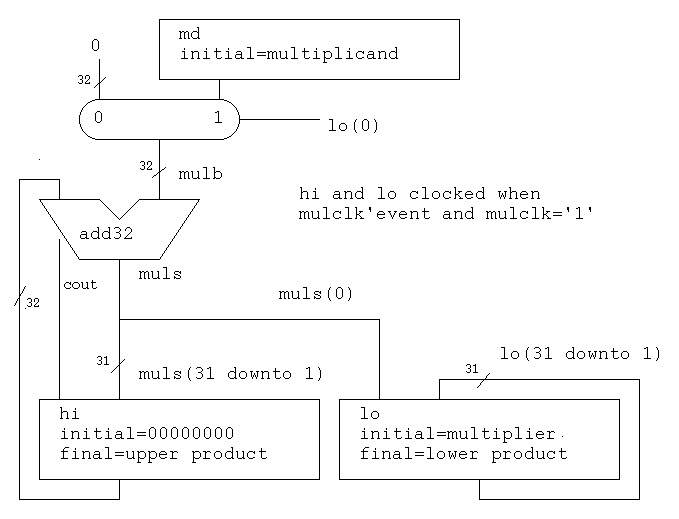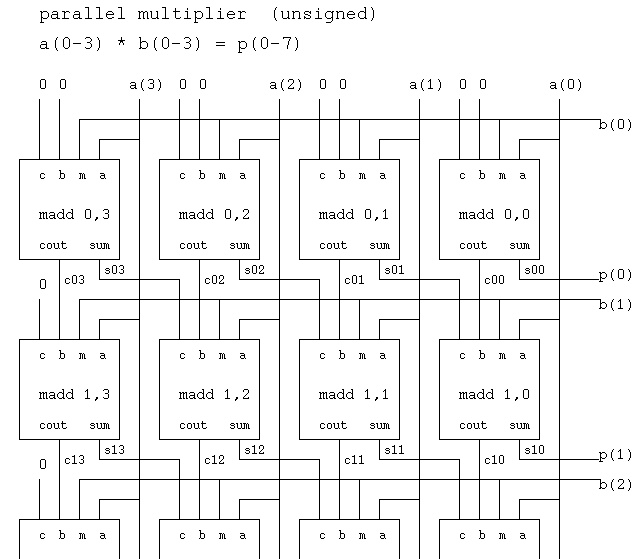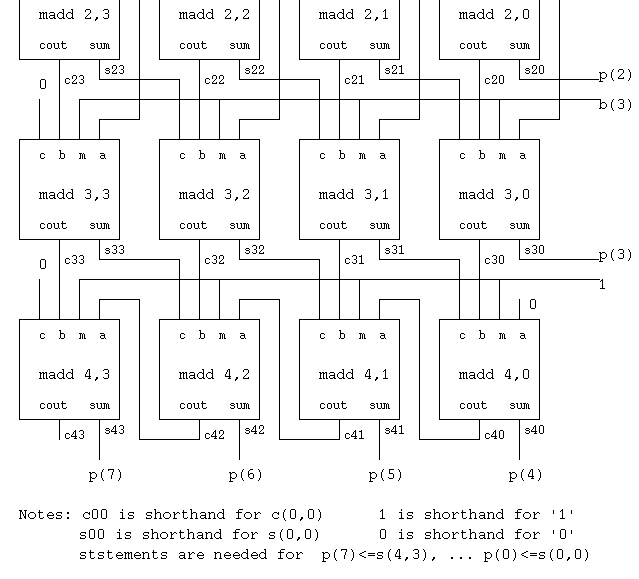<- previous index next ->
Standard decimal and binary multiplication could look like:
234 01010 multiplicand
x 121 x 00011 x multiplier
------ -------- --------------
234 01010 product
468 01010
234 00000
------ 00000
028314 00000
| ----------
| 0000011110 5-bits times 5-bits gives a 10-bit product,
| in a computer leading zeros are kept.
|
3-digits times 3-digits gives a 6-digit product, yet in
decimal, we do not write the leading zeros.
We have covered how computer adders work and how they are built.
Exactly two numbers are added to produce one sum, thus the binary
multiply above needs to be rewritten as:
01010
x 00011
----------
001010 -- multiplier LSB anded with multiplicand
+ 01010 -- multiplier bit-1 anded with multiplicand
-----
0011110 -- partial sum, bottom bit passed down
+ 00000 -- multiplier bit-2 anded with multiplicand
-----
00011110 -- partial sum, bottom two bits passed down
+ 00000 -- multiplier bit-3 anded with multiplicand
-----
000011110 -- partial sum, bottom three bits passed down
+ 00000 -- multiplier bit-4 anded with multiplicand
-----
0000011110 -- final product, four bits passed down
Thus, by this simple method, with a 5-bit unsigned multiplier, there
are four additions needed. A circuit that uses one adder and performs
serial multiplication follows directly. This design chose to use a
multiplexor rather than an 'and' operation to select the multiplicand
or zero.
How a register works
 The VHDL code that represents the above circuit is:
mula <= hi;
mulb <= md when (lo(0)='1') else x"00000000" after 50 ps;
adder:entity WORK.add32 port map(mula, mulb, '0', muls, cout);
hi <= cout & muls(31 downto 1) when mulclk'event and mulclk='1';
lo <= muls(0) & lo(31 downto 1) when mulclk'event and mulclk='1';
The signal "mulclk" runs for the number of clock cycles that
their are bits in the multiplier, 32 for this example. For
simplicity of design, zero is added in the first step. Note that
"cout" is used when loading the "hi" register. The shifting is
accomplished by wire routing.
The VHDL test source code is mul_ser.vhdl
The output from the test is mul_ser.out
P.S. The above was an introduction, never use that method or circuit.
A serial multiplier can be built using only half as many clock cycles.
We use the technique developed by Mr. Booth. Two multiplier bits are
used each clock cycle. Only one add operation is needed each cycle,
yet the augend has several possible values as shown by the
multiplexor in the schematic and the table in the VHDL source code.
The VHDL code that represents the above circuit is:
mula <= hi;
mulb <= md when (lo(0)='1') else x"00000000" after 50 ps;
adder:entity WORK.add32 port map(mula, mulb, '0', muls, cout);
hi <= cout & muls(31 downto 1) when mulclk'event and mulclk='1';
lo <= muls(0) & lo(31 downto 1) when mulclk'event and mulclk='1';
The signal "mulclk" runs for the number of clock cycles that
their are bits in the multiplier, 32 for this example. For
simplicity of design, zero is added in the first step. Note that
"cout" is used when loading the "hi" register. The shifting is
accomplished by wire routing.
The VHDL test source code is mul_ser.vhdl
The output from the test is mul_ser.out
P.S. The above was an introduction, never use that method or circuit.
A serial multiplier can be built using only half as many clock cycles.
We use the technique developed by Mr. Booth. Two multiplier bits are
used each clock cycle. Only one add operation is needed each cycle,
yet the augend has several possible values as shown by the
multiplexor in the schematic and the table in the VHDL source code.
 The VHDL test source code is bmul_ser.vhdl
The output from the test is bmul_ser.out
Next, parallel multiplication with a carry-save design.
Note there is no carry propagation except in the last stage.
The VHDL test source code is bmul_ser.vhdl
The output from the test is bmul_ser.out
Next, parallel multiplication with a carry-save design.
Note there is no carry propagation except in the last stage.


 Some fancy VHDL using double subscripting and "generate".
pmul4.vhdl
A 32 bit design using an add32csa entity is:
Some fancy VHDL using double subscripting and "generate".
pmul4.vhdl
A 32 bit design using an add32csa entity is:

 The VHDL entity for the carry-save multiplier is mul32c.vhdl
The VHDL test source code is mul32c_test.vhdl
The output from the test is mul32c_test.out
We can now combine the Booth multiplication technique to reduce the
number of stages in half, still using the parallel multiply.
The VHDL was written without a diagram, thus no schematic exists, yet.
The VHDL entity for the carry-save multiplier is bmul32.vhdl
The VHDL test source code is bmul32_test.vhdl
The output from the test is bmul32_test.out
Homework 5 is assigned
The VHDL entity for the carry-save multiplier is mul32c.vhdl
The VHDL test source code is mul32c_test.vhdl
The output from the test is mul32c_test.out
We can now combine the Booth multiplication technique to reduce the
number of stages in half, still using the parallel multiply.
The VHDL was written without a diagram, thus no schematic exists, yet.
The VHDL entity for the carry-save multiplier is bmul32.vhdl
The VHDL test source code is bmul32_test.vhdl
The output from the test is bmul32_test.out
Homework 5 is assigned
<- previous index next ->
 The VHDL code that represents the above circuit is:
mula <= hi;
mulb <= md when (lo(0)='1') else x"00000000" after 50 ps;
adder:entity WORK.add32 port map(mula, mulb, '0', muls, cout);
hi <= cout & muls(31 downto 1) when mulclk'event and mulclk='1';
lo <= muls(0) & lo(31 downto 1) when mulclk'event and mulclk='1';
The signal "mulclk" runs for the number of clock cycles that
their are bits in the multiplier, 32 for this example. For
simplicity of design, zero is added in the first step. Note that
"cout" is used when loading the "hi" register. The shifting is
accomplished by wire routing.
The VHDL test source code is mul_ser.vhdl
The output from the test is mul_ser.out
P.S. The above was an introduction, never use that method or circuit.
A serial multiplier can be built using only half as many clock cycles.
We use the technique developed by Mr. Booth. Two multiplier bits are
used each clock cycle. Only one add operation is needed each cycle,
yet the augend has several possible values as shown by the
multiplexor in the schematic and the table in the VHDL source code.
The VHDL code that represents the above circuit is:
mula <= hi;
mulb <= md when (lo(0)='1') else x"00000000" after 50 ps;
adder:entity WORK.add32 port map(mula, mulb, '0', muls, cout);
hi <= cout & muls(31 downto 1) when mulclk'event and mulclk='1';
lo <= muls(0) & lo(31 downto 1) when mulclk'event and mulclk='1';
The signal "mulclk" runs for the number of clock cycles that
their are bits in the multiplier, 32 for this example. For
simplicity of design, zero is added in the first step. Note that
"cout" is used when loading the "hi" register. The shifting is
accomplished by wire routing.
The VHDL test source code is mul_ser.vhdl
The output from the test is mul_ser.out
P.S. The above was an introduction, never use that method or circuit.
A serial multiplier can be built using only half as many clock cycles.
We use the technique developed by Mr. Booth. Two multiplier bits are
used each clock cycle. Only one add operation is needed each cycle,
yet the augend has several possible values as shown by the
multiplexor in the schematic and the table in the VHDL source code.
 The VHDL test source code is bmul_ser.vhdl
The output from the test is bmul_ser.out
Next, parallel multiplication with a carry-save design.
Note there is no carry propagation except in the last stage.
The VHDL test source code is bmul_ser.vhdl
The output from the test is bmul_ser.out
Next, parallel multiplication with a carry-save design.
Note there is no carry propagation except in the last stage.


 Some fancy VHDL using double subscripting and "generate".
pmul4.vhdl
A 32 bit design using an add32csa entity is:
Some fancy VHDL using double subscripting and "generate".
pmul4.vhdl
A 32 bit design using an add32csa entity is:

 The VHDL entity for the carry-save multiplier is mul32c.vhdl
The VHDL test source code is mul32c_test.vhdl
The output from the test is mul32c_test.out
We can now combine the Booth multiplication technique to reduce the
number of stages in half, still using the parallel multiply.
The VHDL was written without a diagram, thus no schematic exists, yet.
The VHDL entity for the carry-save multiplier is bmul32.vhdl
The VHDL test source code is bmul32_test.vhdl
The output from the test is bmul32_test.out
Homework 5 is assigned
The VHDL entity for the carry-save multiplier is mul32c.vhdl
The VHDL test source code is mul32c_test.vhdl
The output from the test is mul32c_test.out
We can now combine the Booth multiplication technique to reduce the
number of stages in half, still using the parallel multiply.
The VHDL was written without a diagram, thus no schematic exists, yet.
The VHDL entity for the carry-save multiplier is bmul32.vhdl
The VHDL test source code is bmul32_test.vhdl
The output from the test is bmul32_test.out
Homework 5 is assigned